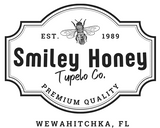Raw Honey: The Natural Way to Heal Wounds
Raw honey has wonderful anti-bacterial properties, and has been used for wound care for centuries. How does it work? Raw honey contains small amounts of the enzyme glucose oxidase which, under the right conditions, can produce hydrogen peroxide. Hydrogen peroxide has long been used as a disinfectant, but it tends to lose its effectiveness fairly quickly when exposed to air and light. Raw honey solves this problem by producing small amounts of hydrogen peroxide directly inside of a bandaged wound.
Two things are required to convert glucose oxidose into hydrogen peroxide -- a pH of 6.1 and sodium. Honey has a low pH and no sodium so human skin and body fluids solve this problem. Author and beekeeper Joe Traynor explains: "[W]hen honey comes into contact with human skin or wounds, the dormant enzyme - glucose oxidase - becomes highly active at the interface of the honey and skin or wound, as bodily fluids raise both the pH and the sodium concentrations to the optimum range of enzyme activity. Thus, minute doses of hydrogen peroxide are continually released from the honey, directly to where they are most needed. Could man devise a more perfect, slow-release antimicrobial product for treating wounds? If a billion dollar, biomedical company gave their research and development scientists unlimited time and resources, it is doubtful they could equal what nature has already provided in honey." Traynor, Joe, Honey:The Gourmet Medicine (2002) at pages 11-12. Traynor then includes a collection of anecdotes in his book regarding the use of honey for healing wounds. Two of these are as follows:
"Bulgarian soldiers suffered numerous casualties while fighting the Serbian army during the Balkan War of 1913. The Bulgarians had run out of medicine to treat the wounded, but came across a small amount of honey in a nearby village. There was not enough honey to provide nourishment for the troops, but the officer in charge, a veterinarian in civilian life, decided to apply the honey to some of the wounds to show his soldiers he cared for their welfare. A few days later, the honey-treated wounds were clean and healing rapidly, while the non treated wounds showed no improvement and had become badly infected."
"A war invalid, aged 25, had a big scar on the back of his right foot. In the center of the scar was an ulcer three by three centimeters with a deep glossy, greyish bottom and necrotic thickened edges. The patient said the wound had been in this state for three months. The application of Vishnevsky ointment, phototherapy and other methods gave no effect. Twenty days after a honey ointment was applied the ulcer healed." Traynor, Joe, Honey:The Gourmet Medicine (2002) at page 14..
It is really amazing to consider that raw honey made by bees is such a superior wound management medicine. But scientific studies back up the claim: "The therapeutic effects after honey application include fast healing, wound cleansing, clearance of infection, tissue regeneration, minimized inflammation, and increased comfort during dressing due to lower extent of tissue adhesion." Pasupuleti, R., et al., Honey, Propolis, and Royal Jelly: A Comprehensive Review of Their Biological Actions and Health Benefits, Journal of Oxidative Medicine and Cellular Longetivity (2017).

